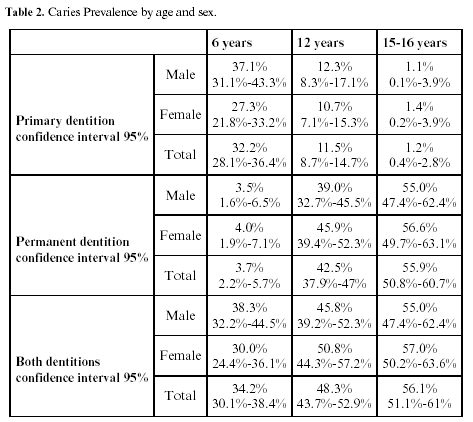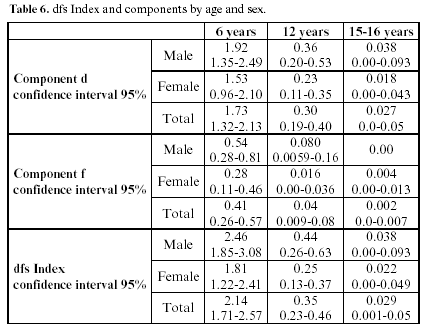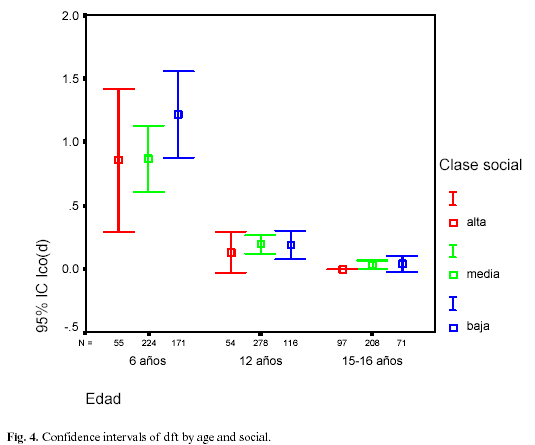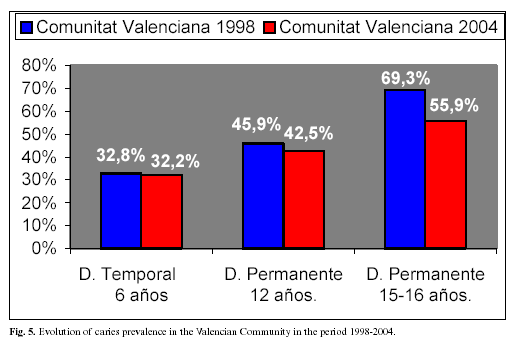Mi SciELO
Servicios Personalizados
Revista
Articulo
Indicadores
-
 Citado por SciELO
Citado por SciELO -
 Accesos
Accesos
Links relacionados
-
 Citado por Google
Citado por Google -
 Similares en
SciELO
Similares en
SciELO -
 Similares en Google
Similares en Google
Compartir
Medicina Oral, Patología Oral y Cirugía Bucal (Internet)
versión On-line ISSN 1698-6946
Med. oral patol. oral cir.bucal (Internet) vol.11 no.4 jul. 2006
Oral health survey of the child population in the Valencia Region of Spain (2004)
Encuesta de salud oral en la población infantil de la Comunidad Valenciana, España (2004)
Jose Manuel Almerich Silla1, Jose Maria Montiel Company2
1Tenured lecturer
2Associate lecturer. Preventive and Community Dentistry. Stomatology Department. University of Valencia
ABSTRACT
Introduction (basis and objectives): The objectives of
this study were to study the evolution of child oral health in the Valencia
Region and establish a six-year interval for these surveys, at a time of major
demographic changes associated with immigration into the region.
Materials and Methods:A cross sectional study was
conducted in a random sample of 509 children aged 6 years, 478 aged 12 years and
401 aged 15-16 years. The clinical examinations were performed by calibrated
dentists (Kappa > 0.85).
Results:Caries prevalence was 32% at 6 years of age (dft=1.08)
in primary dentition and 42.5% at 12 years (DMFT=1.07) and 55.9% at 15-16 years
(DMFT=1.84) in permanent dentition. Caries levels in immigrant children were
significantly high. The mean numbers of sextants with bleeding were 0.16, 1.58
and 1.10 while the scores for sextants with calculus were 0.15, 0.76 and 0.88,
respectively.
Conclusions:Caries levels in both primary and permanent
dentition have remained stable at 6 and 12 years of age and have continued to
fall in the 15-16-year-old age group.
Immigrant children have high caries levels and are a
population group in serious need of treatment and prevention plans.
Key words: Dental epidemiology, dental caries, caries indices, periodontal status, immigration, social class.
RESUMEN
Introducción (fundamento y objetivo): La finalidad de establecer una periodicidad sexenal para estudiar la evolución de salud oral infantil unido a importantes cambios demográficos asociados con la inmigración en la Comunidad Valenciana han motivado este trabajo.
Material y método:Con una muestra seleccionada al azar de 509 niños de 6 años, 478 de 12 años y 401 de 15-16 años se ha realizado un estudio de corte transversal. Los exploraciones clínicas fueron realizadas por odontólogos calibrados (Kappa > 0.85).
Resultados:La prevalencia de caries en dentición temporal a los 6 años es del 32% (Icod=1.08) y en dentición permanente es de 42.5% a los 12 años (ICAOD=1.07) y del 55.9% a los 15-16 años (ICAOD=1.84). Los niveles de caries en los niños inmigrantes son significativamente altos. La media de sextantes con sangrado fue de 0.16, de 1.58 y de 1.10, mientras que con cálculo fue de 0.15, 0.76 y 0.88 respectivamente.
Conclusión:Los niveles de caries tanto en dentición temporal como permanente a los 6 y 12 años se mantienen estables, mientras que a los 15-16 años siguen descendiendo.
Los niños inmigrantes, con altos niveles de caries, constituyen un grupo poblacional con importantes necesidades de tratamiento y de aplicación de programas preventivos.
Palabras clave: Epidemiología dental, caries dental, índice de caries, estado periodontal, inmigración, clase social.
Introduction
In Spain, the transfer of health responsibilities to the autonomous regions has placed most of the planning and organisation of the health services in the hands of the regional governments. Oral care programmes have become differentiated in the different regions and regional oral health surveys have become an important tool for diagnosing the situation and planning new action in the changing demographic panorama of today.
This paper reports the results of the 2004 oral health survey of schoolchildren in the Valencian Community, the latest of the four epidemiological studies conducted throughout this autonomous region.
The first was carried out in 1986 1 to establish the oral health baseline prior to introducing the Bucco-Dental Health Plan. The second region-wide epidemiological study was conducted in 1991 (ESBUD-91) 2 in order to determine the prevalence and intensity of dental caries, level of oral hygiene and treatment needs of the child population of the selected municipalities, as well as serving as a basis for a viability study of locations for future drinking water fluoridation plants. The aim of the third epidemiological study, made in 1998 3, was to assess the situation in the bucco-dental health plan target population and make it possible to evaluate the steps taken to adapt the oral health promotion or preventative measures up to that date. It concluded that the oral health indices in the region presented low scores and were very similar to those of other autonomous regions.
One of the main functions of epidemiological studies is to monitor oral health trends; they are of greater value and estimate the evolution of oral health more accurately when they are conducted at regular intervals. As the previous epidemiological study had been conducted in 1998, it was very important to establish a six-year basis for such studies in the Valencia Region.
Major demographic shifts associated with immigration have taken place in this region over the past six years. The 2004/05 school year enrolment in nursery, primary and obligatory secondary (ESO) schools in the Valencia Region included 58,839 foreign pupils. Many were from countries with high caries indices and underdeveloped health systems. In the latest INE (Spanish National Statistics Institute) census, conducted in 2004, the Valencian population aged between 6 and 16 years numbered 450,000. The influence that the immigrant population may have on caries indices and prevalence is yet to be determined. As the WHO proposes in its new goals for the year 2020 (4), special attention must be paid to the prevalence of dental caries in high-risk groups, which constitute pockets of health disorders.
In the more developed countries, caries indices are no longer falling significantly; the latest Spain-wide data 5 show that caries levels have stabilised in the younger age cohorts. The objective of this study was to determine the evolution of oral health indices in the child population of the Valencia Region over the six-year period from 1998 to 2004.
Materials and methods
Type of study
This was an epidemiological cross sectional study, also known as a cross sectional survey or prevalence survey.
Sample size and selection
The study population, and the group to which the conclusions should be applied, was the children of the Valencia Region. The ages examined were those recommended by the World Health Organisation, which suggests 5 years, 12 years and 15 years as the optimum ages for examination although it notes that 6 years can also be used. In this region, for practical reasons, the children were examined at 6 years rather than 5 in both this and the previous survey, as this is the age when they begin primary school. Sampling by conglomerates was used, considering 1st year primary, 1st year secondary and 4th year secondary classes as conglomerates of children of the representative ages.
Taking the caries prevalence data for each of these ages from the 1998 epidemiological survey and the average conglomerate size in that study as the starting point, the number of conglomerates to be examined was calculated for an initial precision (estimation error defined by the authors) of 0.04 with a 95% confidence level (á = 0.05). Classes in 9 schools in the province of Castellón, 16 in the province of Alicante and 35 in the province of Valencia were selected at random. After carrying out the field work and cleaning the data, the resulting valid sample contained 1388 pupils. Their distribution by age and sex is shown in Table 1.
Calibration prior to examination
To ensure reliable, valid results, the selected dentists were calibrated. During the days prior to the survey, sessions were conducted to explain the diagnostic criteria and train the dentists to carry out the examination, ending with evaluation by means of a calibration test.
Ten 6-year-old children were examined by a reference examiner who was fully conversant with the WHO diagnostic guidelines. The 6 dentists then examined the children. A total of 70 calibration examinations were performed.
The interexaminer consensus was analysed by a Kappa index to determine the strength of agreement between the caries diagnoses. The three dentists with the highest Kappa index results, in a very good consensus range (0.91, 0.857 y 0.85), were appointed examiners. The remaining three were appointed recorders. Three examination teams were formed, each comprising one examiner and one recorder.
Data collection
The examinations were performed in the selected schools, in the spaces assigned by each school for this purpose. The examiners were trained to collect the data under the best possible conditions. The examinations took place with the child sitting on a chair, with his or her neck extended, and the examiner sitting opposite. While the examiner conducted the examination, speaking the results aloud, the recorder sat alongside and filled in the examination record. Illumination was constant during all the examination sessions, as the teams were provided with a portable 60W white-blue spectrum lamp. The examination sessions did not exceed 30 children consecutively to avoid the effects of visual tiredness. The average length of each examination was 5 minutes. Care was taken to avoid noise and crowding in the examination area which could distract the examining team or hinder the data collection process.
The examination instruments employed were a WHO-type periodontal probe and a no. 5 plain mouth mirror. Each examining team was provided with 35 sterilised probe and mirror sets, each in a sealed bag, placed in a portable plastic container. The field work was carried out between 15 November 2004 and 15 December 2004.
Study variables
Caries
All dental surfaces were examined and the WHO criteria 6 were employed for diagnosis and coding. The following indices were calculated: DMFT, dft, significant caries (SiC) 7, filled, decayed and missing teeth and caries prevalence in both primary and permanent teeth. Caries indices and caries prevalence were analysed in relation to nationality and social class.
Social class
Social class was determined in accordance with the classification proposed by Domingo and Martos 8, based on the occupations of the parents, taking the highest of these as the social class of the child.
Nationality
Children of non-Spanish nationality whose parents were foreign and who had been living in Spain for less than 6 years were counted as foreign.
Periodontal status
The Community Periodontal Index (CPI) was employed, using 3 scores (healthy, bleeding after probing and calculus detected) and examining only the 12 and 15-16 year-old children.
Statistical analysis
The data obtained were analysed using the SPSS 10.0® statistics package to compute descriptive statistics with means and proportions, with 95% confidence intervals for each. For the inferential statistics, Students t-test was used to compare means and the chi square test was used to compare proportions.
Results
After excluding the children who did not meet the age criteria and establishing the size of the valid sample from which all the results were to be obtained, the precision of the study was calculated from the caries prevalence for each age group in the 1998 study. With a 0.05 alpha error, i.e. a 95% confidence interval, the assumed maximum error for the 15-16 year-olds was ± 4.5 (å = 0.045). For the 12 year-olds it was ± 4.4 (å = 0.044) and for the 6 year-olds it was ± 4.1 (å = 0.041).
The percentage of caries-free individuals was 65.8% at 6 years and 51.7% at 12 years, falling to 43.9% at 15-16 years. The caries prevalence in primary dentition, permanent dentition and total dentition (both primary and permanent) is shown in Table 2. As regards caries prevalence by sex, no statistically significant differences were encountered.
The DMFT score was 1.07 at 12 years of age and 1.84 at 15-16 years. The DMFT scores and their separate components showed no statistically significant differences by sex (Table 3).
The dft score for the 6-year-olds was 1.08. Decayed teeth were the majority component at both 6 and 12 years of age. Table 5 shows the scores by component and age. By sexes, no statistically significant differences in dft were encountered, although scores were higher in boys at both 6 and 12 years of age. Decay was the majority component for both sexes.
The permanent dentition data show filled rates (FT/DMFT, expressed as a %) of 24.5% at 6 years of age, 32.8% at 12 years and 45.1% at 15-16 years. The primary dentition decayed rate (dt/dft, expressed as a %) for the 6 year-old group was 82.5%, with 84.2% at 12 years and 90.9% at 15-16. The permanent dentition data show decayed rates (DT/DMFT, expressed as a %) of 73.5% at 6 years of age, 65.4% at 12 years and 53.2% at 15-16 years.
The SiC (significant caries index) score, the mean DMFT for the third of the population examined with the highest DMFT scores, was 2.94 at 12 years of age (Table 7).
The foreign population analysed in this sample made up 7.6% of the total 6-year-olds, 6% of the 12-year-olds and 6.4% of the 15-16-year-olds. Their DMFT was 2.43 at 12 years and 4.23 at 15-16 years, while their dft at 6 years was 3.15. These indices are far higher than those of the Spanish children. Statistically significant differences were encountered both in the caries indices and in caries prevalence (Tables 8 and 9). The means and confidence intervals for the caries indices by nationality are shown in Figures 1 and 2.
Analysis by social class encountered no significant differences when comparing the means of the caries indices, although caries indices were found to increase with decreasing social class. Caries prevalence showed no significant differences when analysed by social class (Tables 10 and 11). The means and confidence intervals for the caries indices by social class are shown in Figures 3 and 4.
The percentage of individuals with at least one sealed tooth was 1.6% at age 6, 14.6% at 12 and 12.2% at 15-16 years of age. The mean of sealed teeth at 6 years was 0.03, with 0.33 at 12 years and 0.32 at 15-16 years of age (Table 12).
The mean number of sextants with bleeding at 12 and 15-16 years was 1.58 and 1.10 respectively. The mean number of sextants with calculus was 0.76 at 12 years and 0.88 at 15-16 years of age. Statistically significant differences were encountered between the sexes as regards both the number of sextants with bleeding and the number with calculus at 12 and 15-16 years of age. The girls presented greater bleeding at 12 years but the reverse situation obtained in the 15-16 year-old age group. Calculus was detected more frequently among the boys at both ages (Table 13).
Discussion
Caries prevalence in the primary dentition of 6 year-olds in 2004 remained similar to that observed in 1998 3 in the Valencia Region (32.2% vs. 32.8%). For permanent dentition, caries prevalence at 12 years of age fell slightly (42.5% vs. 45.9%) and the 15-16 year-old age group presented a clear improvement, down from 69.3% in 1998 to 55.9% in 2004 (Figure 5).
For primary dentition, these results can be compared to those of the latest Spain-wide survey (2000) 5, which found 33.3% caries prevalence in primary dentition at 6 years of age, and of the latest survey in Navarre (2002) 9, where the prevalence was 35.4%. For permanent dentition at 12 years the caries prevalence was also similar to the 2000 Spanish figure of 43.3% but the 2002 figure for Navarre was lower (33%). At 15 years, caries prevalence in the Spanish survey was 59.1%, slightly higher than the 55.9% found in the Valencia Region. The distribution of caries prevalence by sex in this region was the same as in 1998. Boys presented greater caries prevalence in primary teeth, mainly at 6 years of age, while girls presented greater prevalence in the 12 and 15-16 age groups; however, none of the differences reached significant levels.
The dft score for the 6 year-olds rose from 1.0 in 1998 to 1.08 in 2004 (Figure 6). This small rise should be considered as having a similar cause to that in Navarre, where a rise in dft has been attributed to a greater immigrant population. Taking the figures for the local population alone, the dft score would be 0.91, a slight improvement, but when the immigrant children (7.6% of the total, dft=3.15) are included in the 6 year-old sample, the total dft rises to 1.08.
On analysing the dft components for 6-year-olds the situation has remained the same as in 1998, with d as the weightiest component of the index. The decayed rate has fallen from 89% to 82%, compared to 84% for Spain as a whole.
The marked downward trend in the 12 year-old DMFT score has slowed over the 1998-2004 period, as this has barely moved, falling from 1.08 to 1.07 (Figure 6).
The most salient feature of this index is the percentage distribution of the components, as the decayed rate has grown from 52.7% to 65.5%, in other words, the number of untreated caries has risen. The decayed figure is 44.6% for Spain as a whole and only 21.3% in Navarre. The filled rate, on the other hand, has fallen from 45.3% to 32.7% in the Valencia Region. The rise in the decayed rate and the fall in the filled rate in this region contrasts with their evolution in Spain as a whole and in the majority of other autonomous regions (10), where the opposite has occurred, particularly in the regions with fully-implemented child dental care programmes. This means that the quality of care in the Valencia Region has worsened (Table 14).
The 15 year-old DMFT score has fallen considerably, from 2.45 to 1.84, and is lower than the 2.2 of the 2000 Spain-wide survey. It is difficult to compare this age group with the latest data from other autonomous regions, as the majority conducted their surveys among 14-year-olds. The percentage distribution of DMFT components at 15 years shows a higher decayed rate and a lower filled rate over the 1998-2004 period, as in the 12-year-olds.
The immigrant population may have raised the 12 and 15-year-old DMFT indices by one or two decimal points, owing to the high indices in this group, despite its comprising only 6%-7% of the total sample. This occurred in Navarre in 2002, although to a lesser extent, raising the 12-year-old DMFT index by about 3 centesimal points.
The significant caries index (SiC) 7 of the 12-year-olds was 2.94. No comparison with any national or regional survey in Spain is possible as none included this index. A slight worsening has been observed, as the 1998 SiC score was 2.87. The explanation is that caries is becoming concentrated in an increasingly smaller percentage of the population. Among 12-year-olds in Navarre (9), 84.3% of the caries was found in only 21.2% of the schoolchildren. This 80:20 (11) phenomenon is found in a very similar form in the Valencia Region, where 85.5% of the caries in 12-year-olds was encountered in 24.4% of this age group.
The mean sealed teeth figure has risen from 0.27 to 0.33 at 12 years and from 0.22 to 0.32 at 15-16 years. The percentage of individuals with sealed teeth has also risen, from 10.56% to 14.6% and from 6.82% to 12.2% at 12 and 15-16 years respectively. In the 2000 Spain-wide survey (5), the mean sealed teeth figure was 0.49 at 12 years and 0.39 at 15-16 years. The percentages of individuals with sealants were 15.5% and 10.6% respectively for these age groups. The mean sealed teeth and percentage of individuals with sealed teeth can be considered indirect indicators of the effect of the regions oral health programme, as sealing fissures is a free, universal service for all schoolchildren in the Valencia Region. The rise has placed this region at very similar levels to the national figures and should be interpreted positively, but is still far from the data for some regions with child dental care programmes where the sealed teeth mean is around 1.
As regards the Community Periodontal Index, the mean number of sextants with bleeding has fallen in all the age groups examined, from 0.58 to 0.16, 1.81 to 1.58 and 1.32 to 1.10 for the 6-, 12- and 15-16-year-old age groups respectively. In the Spain-wide survey of 2000 5, the mean number of sextants with bleeding was 1.32 at 15 years of age. The mean number of sextants with calculus in the Valencia region was very similar to that of 1998 at both 12 and 15-16 years (0.69 vs. 0.76 and 0.89 vs. 0.88). The distribution by sex in 1998 (3) showed that boys had a higher mean numbers of sextants with bleeding at both 12 and 15-16 years. In 2004, this trend held true for the 15-16 age group but was reversed among the 12 year-olds. The national figures show greater bleeding among boys.
Conclusions
The tendency for caries to fall continues in the 15-16 years age group but has stabilised in both permanent and primary dentition at the ages of 6 and 12 years. Nonetheless, it should be pointed out that dental care has worsened, as the proportion of decayed teeth has risen and that of filled teeth has fallen, placing the Valencia Region in an unfavourable position in comparison with other autonomous regions.
Immigration and caries are found to be very strongly related, whereas the relationship with social class is very weak. The immigrant children present very high levels of caries, making them a high-risk group with considerable treatment needs that requires specific prevention programmes.
![]() Correspondence
Correspondence
Dr. Jose
Manuel Almerich Silla
Departament Destomatologia
Clinica Odontològica.
Universitat de València.
C/ Gascó Oliag Nº 1.
46010 - Valencia
E-mail: jose.m.almerich@uv.es
Received: 20-01-2006
Accepted: 25-02-2006
References
1. Zurriaga O, Ibáñez J. La salud bucodental en la Comunidad Valenciana. Encuesta de prevalencia en población infantil. Monografies sanitaries, serie A (Estudis), Número 9.Valencia: Conselleria de Sanitat i consum. Generalitat Valenciana; 1987. [ Links ]
2. Servicio de Epidemiología . Estudio de salud bucodental en escolares de municipios seleccionados. Serie informes de salud, nº 18. Valencia: Dirección General de Salud Pública. Generalitat Valenciana; 1995. [ Links ]
3. Almerich JM, Llena MC, Zurriaga O, Martinez MA, Fullana A, Ortolá JC, et al. Estudio de salud bucodental en la Comunidad Valenciana 1998. Arch Odontoestom Prev Com 2000; 16:569-85. [ Links ]
4. Hobdell M, Petersen PE, Clarkson J, Johnson N. Global goals for oral Health 2020. Int Dent J 2003;53:285-8. [ Links ]
5. Llodra-Calvo JC, Bravo-Pérez M, Cortés-Martinicorena FJ. Encuesta de salud oral en España (2000).RCOE 2002; 7:19-63. [ Links ]
6. WHO. Oral Health Surveys. Basic methods. 4ª ed. Geneva: World Health Organization; 1997. [ Links ]
7. Brathall D. Introducing the significant caries index together with proposal a new global oral health goal for 12-year olds. Int Dent J 2000;50:378-84. [ Links ]
8. Domingo A, Martos J. Propuesta de un indicador de clase social basado en la ocupación. Gac Sanit 1989;3:320-326. [ Links ]
9. Cortés-Martinicorena FJ, Doria-Bajo A, Asenjo-Madoz MA, Sainz de Murieta-Iriarte I, Ramón-Torrel JM, Cuenca-Sala E. Prevalencia de caries y estado periodontal de los niños y adolescentes de Navarra (2002). RCOE 2003; 8:381-90. [ Links ]
10. Sociedad Española de Epidemiología y Salud Pública Oral (SESPO). Banco de datos epidemiológicos. Disponible en: http://www.infomed.es/sespo. [ Links ]
11. Tickle M. The 80:20 phenomenon: help or hindrance to planning caries pervention programes. Community Dent Health 2002;19:39-42. [ Links ]











 texto en
texto en 





















